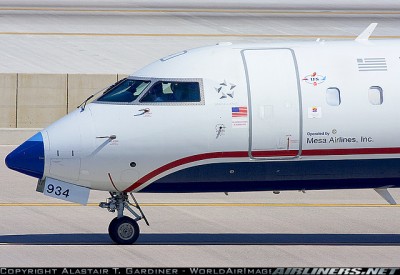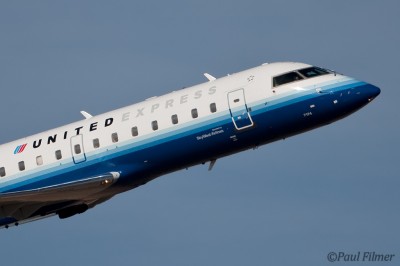
US Airways CRJ-900 with United Airlines nose, operated by Mesa Airlines. Photo by Alastair T. Gardiner.
There are a lot of regional airlines out there. Most are independently operated and contracted out to larger carriers. In most cases, the regional carrier will wear the livery of the larger airline and flying under a capacity purchase agreement.
This relationship is well known to many of us airline nerds, but most of the general public might have a basic idea, but see them as the same airline.
Most regionals are flying just using a bigger airline’s brand. In many cases there are more than one regional airline flying under the same legacy airline’s brand. For example there are nine individual regional airlines currently flying under the same “United Express” brand. When most passengers see “United” or “United Express” they come to expect the same level of service, even if technically the same airline is not flying them.
For me, it is that brand the airline wears that makes all the difference. I have blogged about quite a few instances where employees of a regional airline screw up. When bad things happen with a regional airline, I question whether I should just blame the contracted airline or the legacy carrier whose name is on the side. In most cases I decide to point out that it is a regional airline, contracted out, but blame the legacy carrier.
I have had quite a few people disagree with me on this, even take offense. I can understand the frustration, but the legacy carrier has decided to put their name on the side of the regional carrier’s plane and people expect a certain level of service. The legacy airline’s name is on the ticket, reserved off their site and the employees wear their name tags. As you enter a regional plane, you might noticed the “Operated by ______”, but most people won’t. When the average Joe flies on a regional airline, they feel and expect it is just like them flying on the legacy carrier and I feel the legacy carrier is responsible for the service received.

United Express CRJ operated by Skywest Airlines.Photo by Paul Filmer
When an airline puts their name on something, it is putting their seal of approval for the way they do business. If a passenger has a horrible experience flying on US Airways Express operated by Mesa Airlines, do you think they will be say, “I am never flying Mesa Airlines again?” Of course not, they will blame it on the parent company, US Airways.
Some might think my opinion enforces most passengers’ ignorance to the differences between regionals and their legacy counterparts, but I feel it is important that the legacy airlines hold a lot of responsibility for the actions of employees wearing their uniforms and flying in their colors.
Let’s face it, the use of regional carriers is probably going to continue to grow. Personally, I enjoy the smaller aircraft experience, even when I know most passengers don’t. The reality is it is more cost effective to fly smaller planes and routes where you used to see Boeing 737’s or Airbus A320’s you are starting to see regional jets and props. Where most passengers complain about the smaller cabins, the regional airlines provide cheaper and service more often to more airports than their legacy carriers can accomplish.
Do you know what airline you will be flying on next time you are on a regional flight? I tried to create a list of smaller airlines that fly under the flag or legacy carriers and it wasn’t easy (let me know if I missed anything):
US Airways Express
* Air Wisconsin
* Mesa Airlines
– PSA Airlines
* Chautauqua Airlines
– Piedmont Airlines
* Republic Airlines
* Colgan Air
* Trans States Airlines
Delta Connection
* Atlantic Southest Airlines
– Comair
* Pinnacle Airlines
* Skywest
* Chautauqua Airlines
* Shuttle America
* Freedom Airlines
* Skywest Airlines
Continental Express
* Chautauqua Airlines
* ExpressJet
United Express
* Mesa Airlines
* Atlantic Southeast Airlines
* Chautauqua Airlines
* Republic Airlines
* Colgan Air
* Shuttle America
* GoJet
* Mesa Airlines
* TransStates Airlines
* Skywest
* ExpressJet
American Eagle
– American Eagle
– Executive Airlines
Note: Airlines in italics (with a “-” in front) are actually owned by the legacy’s parent company
I would like to hear your thoughts on this. How do you perceive regional’s relationship to legacy airlines? Should the airline business make more of a distinction?
Images (both used with permission):USAirways by Alastair T. Gardiner
United by Paul Filmer Thanks Court for your help! UPDATE: Some readers have pointed out some regionals I missed under the legacy headers and I have updated them. Thanks!